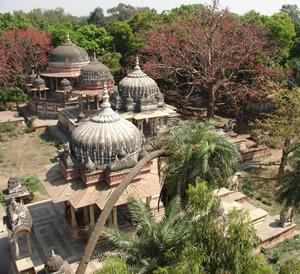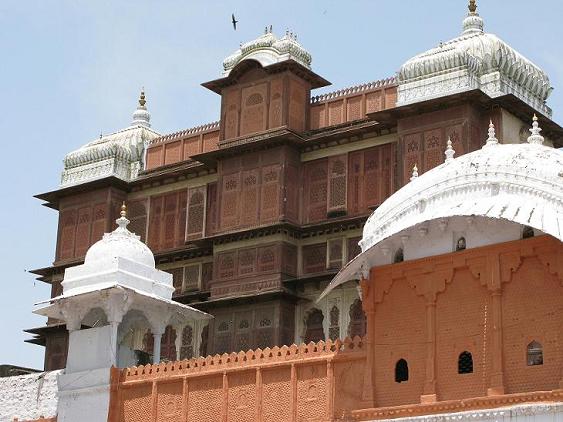
History of kota kota has a versatile history, but what is constant are the battles fought for its possession. kota's early history is shrouded in valour in fact, its very existence owes to a battle-hardened 14 year old Rajput called Rao Madho Singh, the son of Rao Ratan, the ruler of Bundi. Very little is known about this region and its occupants during the pre-historic times. Archeologists have though found some cave paintings in the Alnia and Dara region, which are believed to be from prehistoric times. Stone age remains and tools have been excavated in some areas around Chambal River. Excavations in Kaithun, near kota City show the presence of 'Aryans' in this region. It is very interesting to know that the 'Vedas' addressed Chambal River as Charmanyavati River. According to the 'Purans' and the 'Mahabharata' 'Agnikshaim Yagya' by Raja RantiDev was performed on the banks of this Charmanyavati River. It is said that no one else has ever performed a 'Yagya' so powerful and pious. Lord Parshuram is also said to have resided on the banks of Charmanyavati River. It was here that he performed his 'Yagyas' and 'Pujas'. Historians believe that kota region was initially a part of the Mauryan Dynasty. After their decline it went under the Malwas rule followed by the Gupta empire. It is also believe that the Local rulers belonged to the Snake Dynasty or the 'Naagvansh'. With the downfall of the Gupta's, the region came under the supremacy of Mauryans of Chittor and then under the Parmars of Dhar. With the downfall of the Parmars, a vacuum was created giving a chance to the local 'Bhil' and 'Meena' tribes to establish their supremacy in this region. The next major event in the History of kota was Zalim Singh's ready acceptance of foreign rule. He realized that his forces were no match for the well equipped British Army and compliance was the wisest thing to do. When Pirthi Singh, son of Umed Singh of Bundi ascended the throne of Bundi, kota came within his authority and Zalim Singh carved a completely new principality for his descendants. This set up continued until the whole of India rebelled against British domination. Finally when India became independent, kota became a part of the state of Rajasthan.  12th century saw the rise of Rajputs who forced the Meenas and the Bhils to surrender to their power. In the course of events in 1241 A.D. Hada Chauhan Devi Singh or Rao Deva, captured Bundi from Jaital Meena and became it's ruler. After two years his son Samar Singh succeeded the throne of Bundi and extended the boundaries of his state uptil the west banks of Chambal river. On the eastern side of Chambal, Akelgarh was ruled by Kotia Bhil. Jait Singh, son of Samar Singh defeated Kotia Bhil in the year 1264 A.D. and captured the areas of Akelgarh and kota. kota became a Jagir of the Bundi rulers and Jait Singh was made its ruler. kota remained a Jagir under Bundi rule till the 17th century. Bundi and Mewar state had been at war several times and subsequently Bundi lost its independence to Mewar. In 1646 A.D. kota was taken over by two Pathans - Kesar Khan and Dokar Khan. It was during the same time that Bundi came under the Muslim rulers of Malwa. Rao Surjan Singh soon took over kota and freed it from the clutches of the Muslim rulers and the Pathans. But he accepted the supremacy of Akbar and rulers of Bundi became 'Mansabdars' under the Mughal rule. In the year 1632 A.D. Shahjahan accepted kota as an independent state under the rule of Madho Singh. kota was given eight more 'Parganas' by the Mughal ruler, which included Khajuri, Arandkhera, Kaithun, Aava, Kanvas, Madhukargarh, Digod and Rahal. In this way Madho Singh became the first independent ruler of kota. He was succeeded by Rao Mukund Singh, Rao Jagat Singh followed by Rao Kishore Singh and then by Maharao Bhim Singh. Bhim Singh was the first to be given the title of 'Maharao' by the Mughal rulers. After Maharao Bhim Singh came his son Arjun Singh who died without an heir to his throne. Therefore his brother Durjansal Singh became the ruler. As even he had no son, Ajit Singh became the ruler. The Dynasty continued with Ummed Singh becoming the youngest ruler of kota at the age of 10 years. His father Guman Singh had appointed a Jhala Zalim Singh as his guardian. Zalim Singh was a Jagirdar of Nanta and a very powerful man. He married his daughter to Ummed Singh which increased his power tremendously. The Year 1817 A.D. saw the signing of a pact between the Maharao of kota and the British rule. As per the pact, kota came under the British rule. Maharao of kota remained an Ornamental King while Zalim Singh had all the powers. When Kishore Singh came to the throne he opposed the prevailing setup and was therefore imprisoned by the British and Zalim Singh. He managed to escape and reached Nathdwara. With the help of Maharana of Mewar, an agreement was made and the British gave back the throne to Kishore Singh. It was agreed by the British to pay rupees 1,64,000 annually to Maharao who in return accepted the administration to be run by Zalim Singh and his successors. Due to the differences between successors of Zalim Singh and Kishore Singh, British divided the state of kota into two - kota and Jhalawar, and gave Jhalawar to the successors of Zalim Singh. In 1889, after the death of Maharao Shatrusal, his adopted son Ummed Singh II, the Jagirdar of Kotda became the ruler. He ruled uptil 1940. Because of his work and efforts for the development of this region, Ummed Singh II is called the 'Builder of kota'. Maharao Bhim Singh came to the throne in 1940 and was the ruler at the time of independence. In 1948 when East Rajasthan was unified by combining nine states, kota was made its capital and Maharao Bhim Singh became the head. On 30th march 1949 Rajasthan was united as a state and kota district came into existence. |

